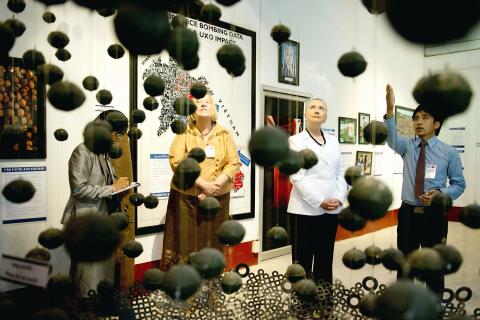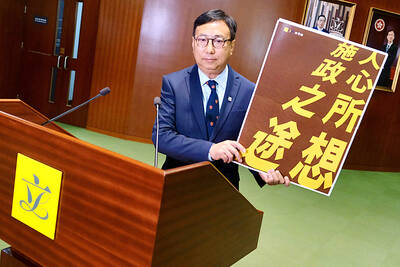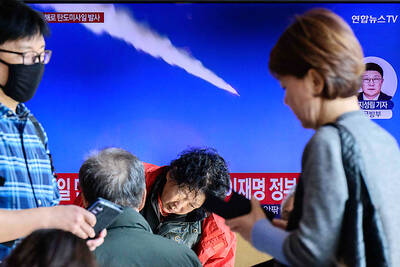US Secretary of State Hillary Rodham Clinton yesterday became the first US secretary of state to visit Laos in 57 years, on a trip focused on the damaging legacy of the Vietnam War and a controversial dam project.
At Vientiane’s flag-bedecked Wattay International Airport, Clinton was given flowers by girls in traditional purple-silk costumes, as she began her brief but historic trip.
“It’s a pretty big deal for the Laotians, and we will underscore a number of areas that we’re working on together,” a senior US official said.

Photo: AFP
These include leftover ordnance from the war that ended in 1975, excavating the remains of US soldiers missing in action and the continuing effects of defoliant Agent Orange, used by the US to try to flush out communist forces.
Clinton, whose four-hour whirlwind trip has been front page news in Laos this week, met with Laotian Prime Minister Thongsing Thammavong at his office in an elegant white-columned building with two large elephant statues outside.
The pair had “substantive discussions on the broadening bilateral cooperation,” a joint statement released after the meeting said.
The two “agreed to improve and further facilitate the accounting operations for American personnel still missing from the Indochina War era” and address the “remaining challenges” of unexploded ordnance, the statement said.
They also discussed the forthcoming entry of Laos into the WTO.
Clinton is only the second US secretary of state to visit Laos after John Foster Dulles, who spent a day in the then-monarchy in 1955. Experts say that all those years ago, they had to clear the water buffalo from the Vientiane airport runway so his plane could land.
Clinton was invited by Laotian Foreign Minister Thongloun Sisoulith in 2010, who was the first top Laotian official to visit Washington since the Soviet-backed communist rebels swept to power, ousting the monarchy, in 1975.
US relations with Laos, while never severed, were long tense, in part over its campaign against the Hmong hill people who assisted US forces during the Vietnam War.
However, the US established normal trade ties with Laos in 2004 and annual US aid to Laos will be around US$30 million in total this year, a US embassy official said.
Of that, US$9.2 million will be set aside this year for cleaning up unexploded ordnance (UXO). US forces dropped more than 2 million tonnes of ordnance on Laos between 1964 and 1973 in about 580,000 bombing missions to cut off North Vietnamese supply lines.
As a result, Laos is the most heavily bombed country, per capita, in history. About 30 percent of the ordnance failed to detonate and all 17 of the country’s provinces still suffer from UXO contamination.
Clinton, who also visited a US-funded orthotic and prosthetic center, discussed “ongoing bilateral cooperation to help resolve the challenges associated with UXO” with Thammavong.
Another of the main thrusts of the trip is talks on controversial plans by Laos to build a massive dam on the Mekong River.
During regional talks in Bali last year, Clinton called for a moratorium on dam building along the river. Activists say the dam projects could spell disaster for 60 million people who depend on the Mekong waterway.
See FOR on page 9

‘CHILD PORNOGRAPHY’: The doll on Shein’s Web site measure about 80cm in height, and it was holding a teddy bear in a photo published by a daily newspaper France’s anti-fraud unit on Saturday said it had reported Asian e-commerce giant Shein (希音) for selling what it described as “sex dolls with a childlike appearance.” The French Directorate General for Competition, Consumer Affairs and Fraud Control (DGCCRF) said in a statement that the “description and categorization” of the items on Shein’s Web site “make it difficult to doubt the child pornography nature of the content.” Shortly after the statement, Shein announced that the dolls in question had been withdrawn from its platform and that it had launched an internal inquiry. On its Web site, Le Parisien daily published a

China’s Shenzhou-20 crewed spacecraft has delayed its return mission to Earth after the vessel was possibly hit by tiny bits of space debris, the country’s human spaceflight agency said yesterday, an unusual situation that could disrupt the operation of the country’s space station Tiangong. An impact analysis and risk assessment are underway, the China Manned Space Agency (CMSA) said in a statement, without providing a new schedule for the return mission, which was originally set to land in northern China yesterday. The delay highlights the danger to space travel posed by increasing amounts of debris, such as discarded launch vehicles or vessel

RUBBER STAMP? The latest legislative session was the most productive in the number of bills passed, but critics attributed it to a lack of dissenting voices On their last day at work, Hong Kong’s lawmakers — the first batch chosen under Beijing’s mantra of “patriots administering Hong Kong” — posed for group pictures, celebrating a job well done after four years of opposition-free politics. However, despite their smiles, about one-third of the Legislative Council will not seek another term in next month’s election, with the self-described non-establishment figure Tik Chi-yuen (狄志遠) being among those bowing out. “It used to be that [the legislature] had the benefit of free expression... Now it is more uniform. There are multiple voices, but they are not diverse enough,” Tik said, comparing it

North Korea yesterday fired a ballistic missile, Seoul’s military said, about a week after US President Donald Trump approved South Korea’s plan to build a nuclear-powered submarine. Analysts have said Seoul’s plan to construct one of the nuclear-driven vessels would likely draw an aggressive response from Pyongyang. South Korea’s Joint Chiefs of Staff said North Korea fired an unidentified ballistic missile toward the East Sea, referring to the body of water also known as the Sea of Japan. The missile landed in the sea outside Japan’s economic waters and no damage or injuries had been reported, Japanese Prime Minister Sanae Takaichi said. The missile